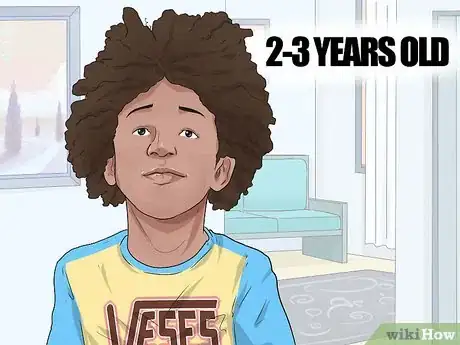This article was co-authored by Laura Marusinec, MD. Dr. Marusinec is a board certified Pediatrician at the Children's Hospital of Wisconsin, where she is on the Clinical Practice Council. She received her M.D. from the Medical College of Wisconsin School of Medicine in 1995 and completed her residency at the Medical College of Wisconsin in Pediatrics in 1998. She is a member of the American Medical Writers Association and the Society for Pediatric Urgent Care.
There are 17 references cited in this article, which can be found at the bottom of the page.
This article has been viewed 79,134 times.
Autism is a spectrum disability, meaning that there are many different ways your child may manifest, or show, signs of autism across a wide spectrum of behaviours. The autistic child experiences disordered brain development that is typically demonstrated through difficulties or differences in intellectual ability, social interaction, nonverbal and verbal communication, and stimming (self-stimulation, such as repetitive movements).[1] Although every autistic child is unique, it is essential to recognize the signs and symptoms as early as possible to secure early intervention services to help you and your child live life to the fullest possible up until adulthood.
Steps
Recognizing Social Differences
-
1Interact with your baby. A typical infant is a social creature by nature and loves to make eye contact. An autistic infant may appear like they are not interacting with parents, or may look "inattentive" to non-autistic parents.
- Make eye contact. A typically developing baby can return eye contact by six to eight weeks of age. An autistic child may not look at you, or may avoid looking at your eyes.
- Smile at your baby. A non-autistic baby can smile and offer warm and happy expressions by six weeks of age or earlier. An autistic baby may not smile, even to a parent.
- Make faces at your baby. See if they mimic you. An autistic child may not participate in playing copycat.
-
2Call your baby’s name. A typical baby will respond to it by nine months of age.[2]
- Typically developing babies will be able to call you Mama or Dada in return by 12 months of age.
Advertisement -
3Play with your toddler. By ages two to three, a typical child will be very interested in playing games with you and others.
- An autistic toddler may appear disconnected from the world, or deep in thought. A non-autistic toddler will be involving you in their world by pointing, showing, reaching, or waving by 12 months of age.
- A typical child engages in parallel play until they are about three years old. When your toddler engages in parallel play, this means they play alongside other children and enjoy their company but do not necessarily engage in cooperative play.[3] Don’t confuse parallel play with an autistic child not being socially engaged.
-
4Examine differences of opinion. By around age five, a typical child can understand that you have a different opinion about things. An autistic child tends to have great difficulty in understanding that others have different points of view, thoughts, and feelings than their own. They often appear to lack empathy for others.
- If your child loves strawberry ice cream, tell your child that chocolate ice cream is your favourite, and see if they argue or get upset that you do not share the same opinion as them.
- Many autistic people understand this better in theory than in praxis.[4] An autistic girl might understand that you like the color blue, but have no idea that it would upset you if she wandered off to check out the balloons across the street.
-
5Assess moods and outbursts. An autistic child may experience meltdowns, or outbursts of extreme emotion that often resemble a temper tantrum.[5] However, these are not voluntary and are extremely upsetting to the child.
- An autistic child experiences many challenges, and may attempt to "bottle up" emotions to please caregivers. Emotions may spiral out of control, and the child can become so frustrated that they engage in self-injury, such as banging their head against a wall or biting themselves.
- Autistic children may experience more pain due to sensory issues, mistreatment, and other problems. They may lash out more often in self-defense.
Watching for Communication Difficulties
-
1Coo to your baby and see if they coo back. Listen for increasing sounds and babbling as they grow. Children usually become fully verbal by 16 to 24 months of age.
- A typical baby will be able to share sounds back-and-forth with you like sharing a conversation by nine months of age. An autistic baby may not be verbal at all or may have been verbal but then lost the skill.
- A typical child will be babbling by about 12 months of age.
-
2Have a conversation. Talk together about your child’s favourite toy and listen to their sentence structure and conversation skills. Typically developing children will have many words by 16 months of age, can create their own meaningful, two-word phrases by 24 months of age, and have coherent sentences by age five.
- An autistic child tends to misplace words in sentence structure or simply repeat others’ phrases or sentences, called parroting or echolalia.[6] [7] They might mix up pronouns, saying "Do you want pancakes?" when they are trying to say that they want pancakes.[8]
- Some autistic children pass over the “kid-speak” phase and have superior language skills. They may learn to speak early, and/or grow large vocabularies. They may converse differently than their peers do.
-
3Try some expressions. Determine if your child takes phrases literally. An autistic child tends to misinterpret body language, tone of voice, and expressions.
- If you have a moment of sarcastic frustration and claim, “How wonderful!” when you find your autistic child has used his red marker all over the living room walls, they may think you literally mean their art is wonderful.
-
4Check their facial expressions, tone of voice, and body language. Autistic children often have unique nonverbal communication. Because most people are used to watching non-autistic body language, this may be confusing to you and others at times.
- Robotic, singsong, or unusually childish tone of voice (even into teen or adult years)
- Body language that does not seem to match their mood
- Little variation in facial expressions, exaggerated facial expressions, or otherwise unique expressions
Identifying Repetitive Behaviours
-
1Watch your child for unusual repetition of behaviours. While all kids enjoy repetitive play to some degree, autistic children will exhibit strong repetitive behaviours such as rocking, hand-flapping, rearranging objects, or repeating sounds over and over again, called echolalia.[9] These can be essential for self-calming and relaxation.
- All children partake in some verbal mimicry until the age of three. An autistic child may do this more often, and beyond the age of three[10]
- Some repetitive behaviours are called self-stimulation or "stimming," meaning that they stimulate the child’s senses. An example of this is if your son wiggles his fingers in front of his eyes to stimulate his vision and amuse himself.
- Another example of stimming happens when the child hums to the exact or near-exact pitch of an external noise (also known as auditory stimulus or stimuli) of something that buzzes or hums that the child can hear, like a bumble bee, a lawn mower, a chainsaw, or even a vibrating cell phone.
-
2Notice how your child plays. Autistic children may not engage in visible imaginative play, preferring to organize objects (e.g. organizing toys or building a city for their dolls instead of playing house). The imagination is occurring inside their head.
- Try breaking the pattern: rearranging the dolls they are lining up or passing in front of them while they are trying to walk in a circle. An autistic child will be noticeably bothered by you interfering.
- Autistic children may be able to engage in imaginative play with another child, especially if that child takes the lead; however, these children will usually not do it on their own.
-
3Recognize special interests and favorite objects. Intense and unusual obsessions with everyday household objects (such as a broom or string) or, later, facts, may be a sign of autism.[11]
- A child may have one special interest at a time, or a few. They can change as the child learns and grows.
-
4Notice a need for routine. Many autistic children have a strong need for routines and consistency, and may show exaggerated reactions or protests to changes in routines. For instance, if you always walk with your child to school taking the same route, try changing it up. An autistic child may become very resistant and upset by this change of routine.
- Routines may have to do with the order of daily tasks, but they may also be verbal (such as asking the same questions repeatedly), have to do with food (only eating foods of a certain color), clothing (only wearing clothes of a specific fabric or color), the location of furniture, and so on.[12]
- Routines can be very comforting for an autistic person. The world can seem unpredictable, confusing, and scary to this person, and a routine can give them some sense of control and stability.
-
5Look for heightened and diminished sensitivity to sensations. If your child shows unusual discomfort to light, textures, sounds, tastes, or temperatures, talk to your doctor.[13]
- Autistic children may "overreact" to new sounds (e.g. a sudden loud noise or a vacuum cleaner), textures (e.g. an itchy sweater or sock), et cetera. This is because the particular sense is magnified, so it causes real discomfort or pain.
Assessing Autism Across the Ages
-
1Know when autism may be noticed. Some symptoms are clear around two to three years of age. Beyond that, a child may be diagnosed at any age, especially during a transition (e.g. going to high school or moving house) or other stressful periods. Excessive life demands may cause an autistic person to "regress" in order to cope,[14] causing concerned loved ones to seek a diagnosis.
- In some children, signs may be noticed in the first one to two years of life.
- Some are not diagnosed until college, when their developmental differences become especially obvious.
-
2Know your childhood milestones. With some variation, most children meet developmental milestones following a specific pattern. Autistic children may meet these milestones later.[15] Some may be precocious, and their parents may consider them a struggling or introverted gifted child.
- By age three, children are often able to walk stairs, work with simple dexterity toys, and play make-believe.
- By age four, a child can retell their favourite stories, scribble, and follow simple directions.
- By age five, a child can generally draw pictures, talk about their day, wash their hands, and focus on a task.
- Older autistic children and teens may exhibit strict adherence to patterns and rituals, engage passionately in special interests, enjoy things that are not typical of their age group,[16] avoid eye contact, and be highly sensitive to touch.
-
3Watch for loss of skills. Speak to your family doctor if you have concerns at any point in your child’s development. Do not delay if your child experiences a loss of speech, self-care skills, or social skills at any age.
- Most skills that are lost are still "there" and can be regained.
Warnings
- This article is intended for general purposes only and is not meant to provide medical advice. If you need help, please consult with your child's pediatrician. Autism can also be diagnosed by a clinical psychologist, neurologist, or psychiatrist.⧼thumbs_response⧽
- There is a false rumor that vaccines cause autism. The CDC confirmed that vaccines do not cause autism.[19]⧼thumbs_response⧽
References
- ↑ http://autisticadvocacy.org/home/about-asan/about-autism/
- ↑ http://www.mayoclinic.org/diseases-conditions/autism-spectrum-disorder/basics/symptoms/con-20021148
- ↑ http://childdevelopmentinfo.com/child-development/play-work-of-children/pl3/
- ↑ http://musingsofanaspie.com/2013/01/17/the-empathy-conundrum/
- ↑ http://autisticadvocacy.org/home/about-asan/about-autism/
- ↑ http://musingsofanaspie.com/2013/09/18/echolalia-thats-what-she-said/
- ↑ https://www.healthychildren.org/English/health-issues/conditions/developmental-disabilities/Pages/Early-Signs-of-Autism-Spectrum-Disorders.aspx
- ↑ http://emmashopebook.com/2012/05/21/come-dance-with-me/
- ↑ http://musingsofanaspie.com/2013/09/18/echolalia-thats-what-she-said/
- ↑ http://www.cdc.gov/ncbddd/autism/signs.html
- ↑ http://autisticadvocacy.org/home/about-asan/about-autism/
- ↑ http://www.autism.org.uk/about/behaviour/obsessions-repetitive-routines.aspx
- ↑ http://www.mayoclinic.org/diseases-conditions/autism-spectrum-disorder/basics/tests-diagnosis/con-20021148
- ↑ http://musingsofanaspie.com/2013/12/19/autistic-regression-and-fluid-adaptation/
- ↑ http://autismsciencefoundation.org/what-is-autism/early-signs-of-autism/
- ↑ http://musingsofanaspie.com/2014/12/12/chronologically-out-of-step/
- ↑ http://www.theguardian.com/society/2012/jul/13/girls-autism-sex-bias-children
- ↑ http://musingsofanaspie.com/2012/08/30/aspergers-differences-in-girls-and-boys/
- ↑ http://www.cdc.gov/vaccinesafety/Concerns/Autism/Index.html
- Emma's Hope Book: Autism is Not a Developmental Delay














































































Medical Disclaimer
The content of this article is not intended to be a substitute for professional medical advice, examination, diagnosis, or treatment. You should always contact your doctor or other qualified healthcare professional before starting, changing, or stopping any kind of health treatment.
Read More...